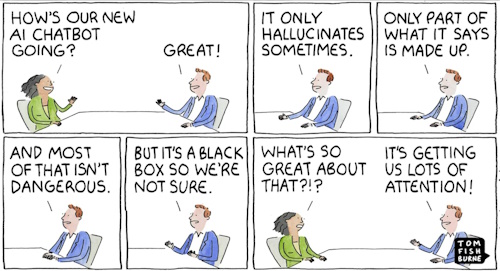 AI Hallucinations
AI Hallucinations
Cases when AI models, particularly large language models (LLMs), generate outputs that are false, misleading, or nonsensical while presenting them as if they are factual
This phenomenon can occur in various AI applications, including chatbots and image recognition systems. AI hallucinations highlight significant challenges in deploying AI systems that generate human-like text or interpret visual data. Understanding their causes and implementing strategies to mitigate their impact is crucial for developing reliable AI applications. As AI technology evolves, addressing these issues will be key to enhancing user trust and ensuring accurate outputs across various applications.
Key Points About AI Hallucinations
An AI hallucination occurs when a model produces information that appears accurate but is actually incorrect or fabricated. This can range from minor inaccuracies to completely made-up facts, often leading to confusion or misinformation.
Causes
- Training Data Issues: Hallucinations often stem from biases or inaccuracies in the training data. If the model is trained on flawed or unrepresentative data, it may learn incorrect patterns.
- Model Complexity: High complexity in models can lead to overfitting, where the model learns noise in the training data instead of the underlying patterns.
- Input Context: Ambiguous or contradictory prompts from users can also contribute to hallucinations, as the model may struggle to generate coherent responses.
Types of Hallucinations
- Factual Inaccuracies: The model presents incorrect information as if it were true (e.g., naming a city incorrectly).
- Contradictions: The output may contradict itself or previous statements made by the model.
- Irrelevant Responses: Sometimes, the model generates responses that are unrelated to the prompt. Examples: A chatbot might claim that a historical event occurred in a year that is factually incorrect or an AI might generate a recipe but include unrelated weather information, making it nonsensical.

Consequences
AI hallucinations can undermine user trust and lead to poor decision-making, especially in critical fields like healthcare or finance where accurate information is vital. They can also contribute to the spread of misinformation if not properly managed.
Mitigation Strategies
To reduce hallucinations, users can provide clear and specific prompts, use examples to guide the model, and tune parameters that control output randomness. Continuous improvement of training datasets and algorithms is essential for minimizing these occurrences.
 Links
Links
en.wikipedia.org/wiki/Hallucination_(artificial_intelligence)
ibm.com/topics/ai-hallucinations
techtarget.com/whatis/definition/AI-hallucination
builtin.com/artificial-intelligence/ai-hallucination
miquido.com/ai-glossary/ai-hallucinations/
infobip.com/glossary/ai-hallucinations
kindo.ai/blog/45-ai-terms-phrases-and-acronyms-to-know
mitsloanedtech.mit.edu/ai/basics/addressing-ai-hallucinations-and-bias/